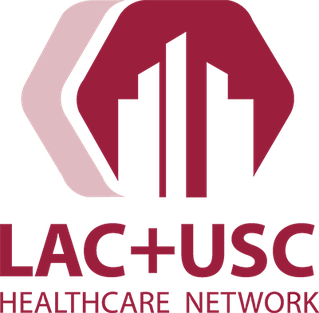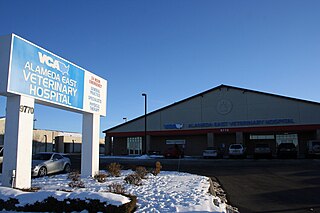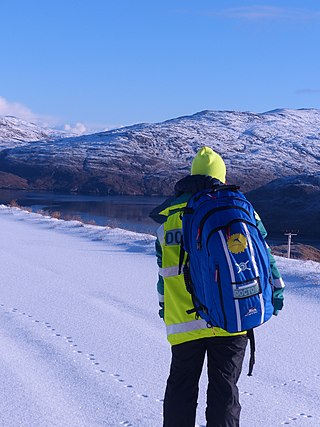
An emergency department (ED), also known as an accident and emergency department (A&E), emergency room (ER), emergency ward (EW) or casualty department, is a medical treatment facility specializing in emergency medicine, the acute care of patients who present without prior appointment; either by their own means or by that of an ambulance. The emergency department is usually found in a hospital or other primary care center.

Los Angeles General Medical Center is a 600-bed public teaching hospital located at 2051 Marengo Street in the Boyle Heights neighborhood of Los Angeles, California, and one of the largest academic medical centers in the United States. The hospital facility is owned by Los Angeles County and operated by the Los Angeles County Department of Health Services. Doctors are faculty of the Keck School of Medicine of USC, who oversee more than 1,000 medical residents being trained by the faculty. Additionally, the United States Navy sends doctors, nurses and corpsmen to train at the hospital, working alongside staff in the trauma center.

Alameda East Veterinary Hospital is a veterinary hospital located in Denver, Colorado, United States.
Trauma: Life in the E.R. is a medical-based television reality show that formerly ran on TLC from 1997 to 2002 and reruns are currently airing on Discovery Life. At its peak, Trauma was one of TLC's top-rated shows and spawned two spin-offs, Paramedics and Code Blue. The series itself was nominated for seven Emmys.

The Martin Luther King Jr. Outpatient Center, formerly known as Martin Luther King Jr. Multi-Service Ambulatory Care Center, Martin Luther King Jr./Drew Medical Center (King/Drew), and later Martin Luther King Jr.–Harbor Hospital, was a public urgent care center and outpatient clinic and former hospital in Willowbrook, an unincorporated section of Los Angeles County, California, north of the city of Compton and south of the Watts neighborhood of Los Angeles. It closed in 2007.
Hospital emergency codes are coded messages often announced over a public address system of a hospital to alert staff to various classes of on-site emergencies. The use of codes is intended to convey essential information quickly and with minimal misunderstanding to staff while preventing stress and panic among visitors to the hospital. Such codes are sometimes posted on placards throughout the hospital or are printed on employee identification badges for ready reference.

Northridge Hospital Medical Center is a hospital in the Northridge district of Los Angeles, California, US. It is currently operated by Dignity Health.

Highland Hospital is a public hospital in Alameda County, Oakland, California. It is operated by the Alameda Health System. It is the primary trauma center and a county hospital in Alameda County.
Trauma surgery is a surgical specialty that utilizes both operative and non-operative management to treat traumatic injuries, typically in an acute setting. Trauma surgeons generally complete residency training in general surgery and often fellowship training in trauma or surgical critical care. The trauma surgeon is responsible for initially resuscitating and stabilizing and later evaluating and managing the patient. The attending trauma surgeon also leads the trauma team, which typically includes nurses and support staff, as well as resident physicians in teaching hospitals.
"24 Hours" is the pilot episode of the medical drama series ER. It first aired on NBC in the United States on September 19, 1994. The episode was written by Michael Crichton, adapted from a screenplay he originally wrote in 1974, and directed by Rod Holcomb. The episode was a critical and commercial success, receiving both high ratings and very favorable critics reactions.

Air medical services are the use of aircraft, including both fixed-wing aircraft and helicopters to provide various kinds of medical care, especially prehospital, emergency and critical care to patients during aeromedical evacuation and rescue operations.

Kings Cross ER: St Vincent's Hospital was an Australian factual television show that looks at the work of the Emergency Department at St Vincent's Hospital in Darlinghurst, Sydney. This observational documentary series began on the Crime & Investigation Network on 2 February 2012. A second season began on 14 February 2013. A third season began in 2015 on the free-to-air Nine Network and aired 7:30 pm Thursdays.

Madrigal v. Quilligan was a federal class action lawsuit from Los Angeles County, California, involving sterilization of Latina women that occurred either without informed consent, or through coercion. Although the judge ruled in favor of the doctors, the case led to better informed consent for patients, especially those who are not native English speakers.
An underground hospital is a hospital that is constructed underground to protect patients and staff from attack during war. They were often used during World War II but very few now remain operational.

Emergency Room: Life + Death at VGH is a medical documentary series which premiered on British Columbia's Knowledge Network on January 21, 2014. It follows doctors, nurses and staff at Vancouver General Hospital (VGH) as they cope with real patients from the Greater Vancouver Regional District. VGH is the second largest hospital in Canada and British Columbia's only level I trauma centre. Stories of stabbings, car accidents, heart attacks, and life-threatening disease are shown alongside everyday cuts and sprains, drunks, and other minor cases, and episodes contain graphic images of wounds, blood, and/or routine and invasive medical procedures.

Code Black is an American medical drama television series created by Michael Seitzman that premiered on CBS on September 30, 2015. It takes place in an overcrowded and understaffed emergency room in Los Angeles, California, and is based on a documentary by Ryan McGarry. On May 16, 2016, the show was renewed for a 13-episode second season, which premiered on September 28, 2016. On November 14, 2016, CBS added three more episodes, to bring the total to 16.

Pre-hospital emergency medicine, also referred to as pre-hospital care, immediate care, or emergency medical services medicine, is a medical subspecialty which focuses on caring for seriously ill or injured patients before they reach hospital, and during emergency transfer to hospital or between hospitals. It may be practised by physicians from various backgrounds such as anaesthesiology, emergency medicine, intensive care medicine and acute medicine, after they have completed initial training in their base specialty.
Ryan McGarry is an American writer, director, cinematographer and emergency physician who directed the documentary Code Black. Code Black is the basis for the TV series Code Black.

The United States has many regions which have been described as medical deserts, with those locations featuring inadequate access to one or more kinds of medical services. An estimated thirty million Americans, many in rural regions of the country, live at least a sixty-minute drive from a hospital with trauma care services. Regions with higher rates of Medicaid and Medicare patients, as well those who lack any health insurance coverage, are less likely to live within an hour of a hospital emergency room. Although concentrated in rural regions, health care deserts also exist in urban and suburban areas, particularly in predominantly Black communities in Chicago, Los Angeles and New York City. Racial demographic disparities in healthcare access are also present in rural areas, particularly in Native American communities which experience worse health outcomes and barriers to accessing quality medical care. Limited access to emergency room services, as well as medical specialists, leads to increases in mortality rates and long-term health problems, such as heart disease and diabetes.
The impact of the COVID-19 pandemic on hospitals became severe for some hospital systems of the United States in the spring of 2020, a few months after the COVID-19 pandemic began. Some had started to run out of beds, along with having shortages of nurses and doctors. By November 2020, with 13 million cases so far, hospitals throughout the country had been overwhelmed with record numbers of COVID-19 patients. Nursing students had to fill in on an emergency basis, and field hospitals were set up to handle the overflow.













